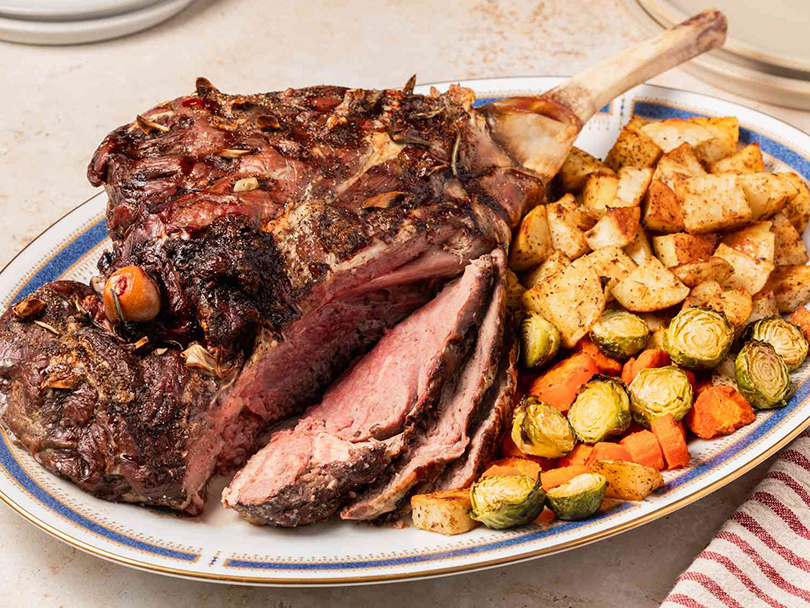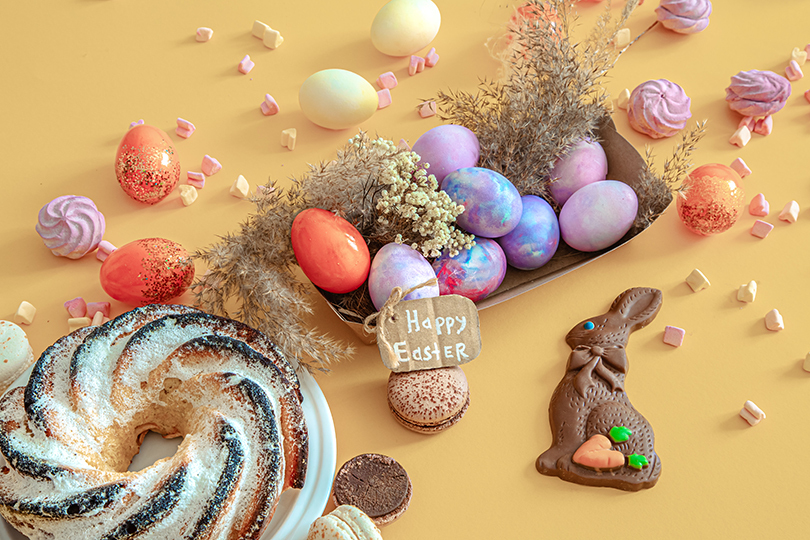Easter is a holiday that brings everyone together at the table. It’s filled with light, love, spring warmth — and of course, delicious food. Whether you’re planning an Easter breakfast, visiting friends and family, or simply want to treat yourself to something special, here’s a collection of dishes to try. They’re not only tasty but rich in tradition and symbolism. And the recipes? Simple and easy to follow.
Paska (Easter Bread)
What it symbolizes:
Paska is a sweet, rich bread that symbolizes joy and resurrection. It’s often decorated with icing, sprinkles, or patterns. In many families, it’s the centerpiece of the Easter table.
What it symbolizes:
Paska is a sweet, rich bread that symbolizes joy and resurrection. It’s often decorated with icing, sprinkles, or patterns. In many families, it’s the centerpiece of the Easter table.

You’ll need:
- 500 g flour
- 3 eggs
- 100 g sugar
- 100 ml milk
- 100 g melted butter
- 25 g fresh yeast or 7 g dry yeast
- 1 tsp vanilla sugar
- A pinch of salt
- Zest of 1 lemon
- Warm the milk (not hot), add the yeast, 1 tsp sugar, and a little flour. Let it sit for 15–20 minutes until it becomes foamy.
- In a separate bowl, beat the eggs with the sugar, then add vanilla, lemon zest, salt, and melted butter. Mix in the yeast mixture.
- Gradually add flour and knead the dough until smooth. Cover and let it rise for 1.5–2 hours.
- Place the dough in a baking mold and let it rise for another 30–40 minutes.
- Bake at 180°C (350°F) for about 30–40 minutes. Let cool and optionally top with icing made from powdered sugar and lemon juice.
*****
Stuffed Eggs
What they symbolize:
Eggs represent new life and resurrection. This simple appetizer is a tasty and festive way to serve them.
What they symbolize:
Eggs represent new life and resurrection. This simple appetizer is a tasty and festive way to serve them.

You’ll need:
How to make it:
Tip: Add a bit of avocado, horseradish, or curry to the filling for a unique twist.
- 6 boiled eggs
- 2 tbsp mayonnaise
- 1 tsp mustard
- Salt and pepper
- Paprika for garnish
- Optional: herbs or pickles
How to make it:
- Peel and halve the eggs, then remove the yolks.
- Mash the yolks with mayonnaise, mustard, salt, and pepper.
- Fill the whites with the mixture using a spoon or piping bag.
- Sprinkle with paprika.
Tip: Add a bit of avocado, horseradish, or curry to the filling for a unique twist.
*****
Baked Ham
What it symbolizes:
Ham has long been an Easter tradition in Western Europe — cured since fall and ready just in time for the holiday. Today, it’s a symbol of comfort and celebration.
What it symbolizes:
Ham has long been an Easter tradition in Western Europe — cured since fall and ready just in time for the holiday. Today, it’s a symbol of comfort and celebration.

You’ll need:
How to make it:
The aroma is incredible — and it’s even better cold the next day.
- 1.5–2 kg cooked ham
- 3 tbsp honey
- 1 tbsp mustard
- 2 tbsp brown sugar
- 1 tbsp apple cider vinegar
- Optional: whole cloves for garnish
How to make it:
- Score the ham in a crisscross pattern and insert cloves if desired.
- Mix honey, mustard, sugar, and vinegar to make a glaze.
- Brush the glaze over the ham.
- Bake at 180°C (350°F) for about 45 minutes, basting every 15 minutes.
The aroma is incredible — and it’s even better cold the next day.
*****
Easter Cheese
What it symbolizes:
This sweet curd cheese is a traditional Easter dish in many countries. It symbolizes purity, moderation, and the end of Lent.
What it symbolizes:
This sweet curd cheese is a traditional Easter dish in many countries. It symbolizes purity, moderation, and the end of Lent.

You’ll need:
How to make it:
It’s delicate, slightly sweet — perfect with paska.
- 1 liter milk
- 5 eggs
- 2 tbsp sugar
- A pinch of salt
- 1 tsp vanilla (optional)
How to make it:
- Combine all ingredients in a saucepan and cook over low heat, stirring constantly.
- The mixture will curdle and resemble large flakes.
- Pour into a cheesecloth, tie it into a bundle, and hang to drain overnight.
- In the morning, slice and serve.
It’s delicate, slightly sweet — perfect with paska.
*****
Roast Lamb
What it symbolizes:
The lamb is a powerful symbol of Christ. This dish connects Christian Easter to the Jewish Passover, where the tradition originated.
What it symbolizes:
The lamb is a powerful symbol of Christ. This dish connects Christian Easter to the Jewish Passover, where the tradition originated.

You’ll need:
How to make it:
Serve with potatoes, herbs, or salad.
- 1.5–2 kg lamb shoulder or leg
- 4 garlic cloves
- 2 tbsp olive oil
- 1 tbsp rosemary
- Salt, pepper, lemon juice
How to make it:
- Rub the lamb with oil, garlic, rosemary, lemon juice, salt, and pepper.
- Marinate for at least 2 hours (overnight is better).
- Roast at 180°C (350°F) for 1.5–2 hours, until the meat is tender and golden.
Serve with potatoes, herbs, or salad.
*****
Beet & Horseradish Relish
What it symbolizes:
Horseradish represents the bitterness of suffering, but mixed with sweet beets, it becomes a symbol of hope and victory. This side is popular in parts of Europe.
What it symbolizes:
Horseradish represents the bitterness of suffering, but mixed with sweet beets, it becomes a symbol of hope and victory. This side is popular in parts of Europe.

You’ll need:
How to make it:
Pairs wonderfully with meat and eggs.
- 2 small boiled beets
- 2–3 tbsp grated horseradish
- 1 tsp sugar
- A splash of vinegar
- Salt to taste
How to make it:
- Simply grate everything, mix, and chill.
Pairs wonderfully with meat and eggs.
*****
Carrot Cake
What it symbolizes:
Simple: carrots are linked to bunnies, and bunnies are a classic Easter symbol. Carrot cake makes for a perfect holiday dessert.
What it symbolizes:
Simple: carrots are linked to bunnies, and bunnies are a classic Easter symbol. Carrot cake makes for a perfect holiday dessert.

You’ll need:
For the frosting:
How to make it:
The result: a moist, spiced cake that’s full of flavor.
- 2 cups grated carrot
- 1.5 cups flour
- 1 tsp baking soda
- 1 tsp cinnamon
- ½ tsp nutmeg
- 2 eggs
- ¾ cup sugar
- ½ cup vegetable oil
- ½ cup chopped nuts (optional)
- A pinch of salt
For the frosting:
- 200 g cream cheese
- 50 g butter
- 1 cup powdered sugar
- 1 tsp vanilla
How to make it:
- Beat eggs with sugar and oil, then stir in the carrots.
- In another bowl, mix all the dry ingredients.
- Combine wet and dry ingredients, then add nuts.
- Bake at 175°C (350°F) for 35–40 minutes.
- For the frosting, beat everything until fluffy and spread over the cooled cake.
The result: a moist, spiced cake that’s full of flavor.
*****
Easter Eggs — A Must-Have on the Table
Dyed boiled eggs are a symbol of new life. People exchange them, give them as gifts, and play the traditional egg-cracking game.
Dyed boiled eggs are a symbol of new life. People exchange them, give them as gifts, and play the traditional egg-cracking game.

Here are a few simple ways to dye eggs:
In onion skins (classic):
With natural dyes:
With patterns:
In onion skins (classic):
- Boil eggs in water with onion skins and a spoonful of salt. The longer they boil, the deeper the color.
- Pro tip: Add a little vinegar for more vibrant color.
With natural dyes:
- Beetroot = pink
- Turmeric = bright yellow
- Red cabbage = blue or purple
- Spinach = green
- Just add the ingredient and a splash of vinegar to water, then boil the eggs in it.
With patterns:
- Wrap eggs with threads or parsley leaves, place in an old nylon stocking, tie, and boil in onion skins or dye.
- This creates unique designs.
Easter dishes are more than just food. They’re traditions, symbols, childhood memories, and shared moments with loved ones. May your table be warm, aromatic, and full of homey comfort.






